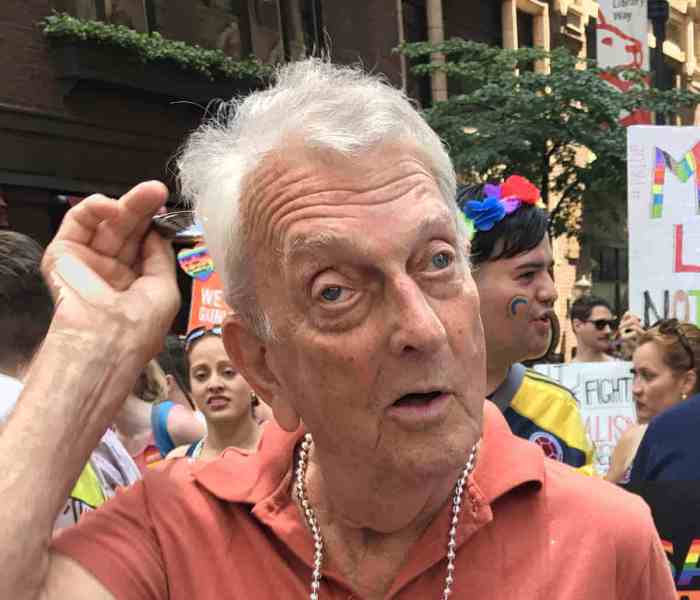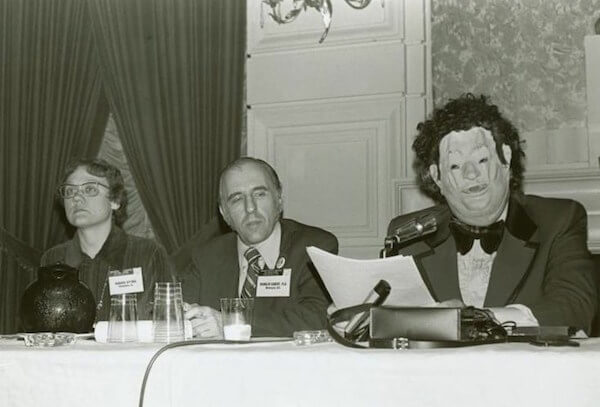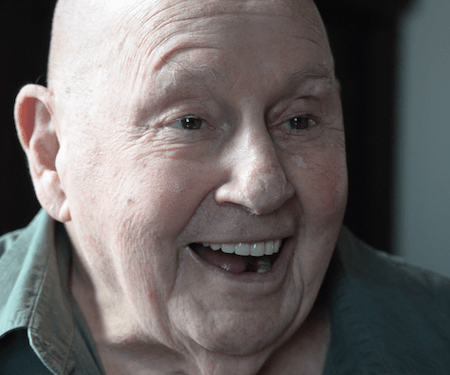BY DUNCAN OSBORNE | There are moments in “Stonewall,” Roland Emmerich’s film about the 1969 riots that launched the modern LGBT rights movement, that look more like a set on a stage than a movie.
“It all started with my choice of writer a little bit,” the director told Gay City News during a phone interview, referring to Jon Robin Baitz. “He writes great theater. I always knew I would get kind of a theatrical quality out of him.”
While Baitz has written for film and television, he is best known for his plays. The film was shot on a stage over 42 days in Montreal, with Emmerich providing most of the estimated $14 to $17 million budget. Emmerich, who is gay, and his producers looked at and rejected sites in New York City as logistically impossible.
“We realized very fast that we could not shoot this movie on location,” he said. “We knew we had to shoot this on a set.”
Director Roland Emmerich talks about his new film “Stonewall”
The result is a mix of artifice and reality, with the artifice pierced in moments by some very powerful scenes, including what for most viewers will be the first film depiction of the start of the riots that ran over several days in June 1969. The LGBT community has read about the riots, seen a few pictures of their aftermath, and heard them described by participants and witnesses. Seeing them vividly represented for the first time is breathtaking. Indeed, that scene feels as if it is too short.
Emmerich chose to make Stonewall a personal story, which departs from the status that story has had in the LGBT community since 1969. For decades, the wider community has cared little about who was there, seeing Stonewall as the moment when we, not one person, struck back at a police force and a society that had been brutalizing us for too long.
Emmerich included some real figures in the Stonewall story, including Marsha P. Johnson. Seymour Pine, Ed Murphy, Frank Kameny, and Bob Kohler, but his story is told largely by a group of fictional characters including Danny, a gay kid from Indiana, played by Jeremy Irvine, and Ray/ Ramona, a scare queen played by Jonny Beauchamp, who leads a pack of street kids who adopt Danny when he arrives in New York City.
“It’s the only way I can make movies,” Emmerich said. “I have a very personal connection to stories… The character Danny was inspired by a young kid I know… I need something that personal.”
We see Danny move from the kid who is in love with the quarterback of his high school football team, Joe, played by Karl Glusman, and is forced from his home after the two of them are caught having sex. Thrown out of his home, Danny travels to New York City three months before he is to attend Columbia University on a scholarship. He is beaten by police and witnesses the brutality that Ray and her peers contend with. Danny sees Kohler and his partner living as the 1969 equivalent of a married gay couple. He is seduced and discarded by Trevor, an older activist played by Jonathan Rhys Meyers. At the start of the riots, it is Danny who throws the first brick.
When Danny returns to Indiana for a visit a year later, Joe is married and expecting a child. After a brief conversation, Danny begins to leave and Joe smothers him in a hug and will not let go. It is Danny who is free, but that is not how Emmerich sees that scene.
“I wanted to make a movie about unrequited love,” Emmerich said. “In my youth, I was in love with a kid… I wanted to have a story like that in there… In the end, Danny goes back only to be absolutely sure.”
The use of fictional characters and their stories notwithstanding, Emmerich’s portrayal of the riot hews closely to the description in David Carter’s 2004 book, “Stonewall: The Riots That Sparked the Gay Revolution,” the definitive account of that event. Carter was not consulted on the film.
“I read everything you can read about the Stonewall riots and what you learn really fast is there are different accounts that don’t really match up,” Emmerich said.
The first trailer for the film drew protests over whitewashing because it was a white, gay guy throwing the first brick. Emmerich’s choice is defensible as there is support for it in reliable histories. Featuring the street kids as the instigators of the riot, as Emmerich does, is supported by reliable testimony as well. That was Kohler’s position.
“He kind of felt it was these kids,” Emmerich said. He declined to respond to the protest saying “It’s based on a trailer. I don’t comment on trailers.”
Ultimately, Emmerich said he and Baitz wanted a diverse group represented in the film and they achieved that.
“Robbie and I tried to portray different gay people,” he said. “Danny was always meant to be a catalyst character… I have to say I fell in love with all these characters.”
Stonewall opens on September 25 with a “100-print release,” said Emmerich, who joked that he might not earn his money back. That means the movie will show in “every major city in America with one or two prints… A movie like this will never play with more than 300 prints. It’s more like an art house movie,” he said.
It is unlikely that the film would have been made at all if Emmerich, who is known for directing blockbuster films, such as “Independence Day” and “The Day After Tomorrow,” had not championed it.
“Nobody wanted to make this film,” he said. “You have to have a big name to get it made.”
STONEWALL | Directed by Roland Emmerich | Roadside Attractions | Opens Sep. 25 | Angelika Film Center, 18 W. Houston at Mercer St.; angelikafilmcenter.com/nyc | Bow Tie Chelsea Cinemas, 260 W. 23rd St.; bowtiecinemas.com | AMC Lincoln Square 13, 1998 Broadway at W. 68th St.; amctheatres.com
Read Steve Erickson's review of “Stonewall” here.





































